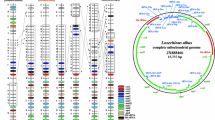Abstract
A fragment of the mitochondrial COI gene from isolates of several echinoderm species was sequenced. The isolates were from three species of starfish from the Asteriidae family (Asterias amurensis and Aphelasterias japonica collected in the Sea of Japan and Asterias rubens collected in the White Sea) and from the sea urchin Echinocardium cordatum (family Loveniidae) collected in the Sea of Japan. Additionally, regions including internal transcribed spacers and 5.8S rRNA (ITS1–5.8S rDNA–ITS2) were sequenced for the three studied starfish species. Phylogenetic analysis of the obtained COI sequences together with earlier determined homologous COI sequences from Ast. forbesii, Ast. rubens, and Echinocardium laevigaster from the North Atlantic and E. cordatum from the Yellow and North Seas (GenBank) placed them into strictly conspecific clusters with high bootstrap support (99% in all cases). Only two exceptions–Ast. rubens DQ077915 sequence placed with the Ast. forbesii cluster and Aph. japonica DQ992560 sequence placed with the Ast. amurensis cluster–were likely results of species misidentification. The intraspecific polymorphism for the COI gene within the Asteriidae family varied within a range of 0.2-0.9% as estimated from the genetic distances. The corresponding intrageneric and intergeneric values were 10.4-12.1 and 21.8-29.8%, respectively. The interspecific divergence for the COI gene in the sea urchin of Echinocardium genus (family Loveniidae) was significantly higher (17.1-17.7%) than in the starfish, while intergeneric divergence (14.6-25.7%) was similar to that in asteroids. The interspecific genetic distances for the nuclear transcribed sequences (ITS1–5.8S rDNA–ITS2) within the Asteriidae family were lower (3.1-4.5%), and the intergeneric distances were significantly higher (32.8-35.0%), compared to the corresponding distances for the COI gene. These results suggest that the investigated molecular-genetic markers could be used for segregation and identification of echinoderm species.
Similar content being viewed by others
References
Shneyer, V. S. (2007) On the species-specificity of DNA: fifty years later, Biochemistry (Moscow), 72, 1377–1384.
Shubina, E. A., Ponomareva, E. V., Klimov, A. V., Klimova, A. V., and Kedrova, O. S. (2015) Repetitive DNA sequences as an indicator of the level of genetic isolation in fish, Mol. Biol. (Moscow), 49, 405–416.
Ward, R. D., Holmes, B. H., and O’Hara, T. D. (2008) DNA barcoding discriminates echinoderm species, Mol. Ecol. Resour., 8, 1202–1211.
Minin, K. V., Petrov, N. B., and Vladychenskaya, I. P. (2015) Sea urchins of the genus Gracilechinus Fell & Pawson, from the Pacific Ocean: morphology and evolutionary history, Marine Biol. Res., 11, 253–268.
Wares, J. P. (2001) Biogeography of Asterias: North Atlantic climate change and speciation, Biol. Bull., 201, 95–103.
Goffredi, S. K., Hurtado, L. A., Hallam, S., and Vrijenhoek, R. C. (2003) Evolutionary relationships of deep-sea vent and cold seep clams (Mollusca: Vesicomyidae) of the “pacifica/lepta” species complex, Marine Biol., 142, 311–320.
Audzijonyte, A., Krylova, E. M., Sahling, H., and Vrijenhoek, R. C. (2012) Molecular taxonomy reveals broad trans-oceanic distributions and high species diversity of deep-sea clams (Bivalvia: Vesicomyidae: Pliocardiinae) in chemosynthetic environments, System. Biodivers., 10, 403–415.
Krylova, E. M., Kamenev, G. M., Vladychenskaya, I. P., and Petrov, N. B. (2015) Vesicomyinae (Bivalvia: Vesicomyidae) of the Kuril–Kamchatka Trench and adjacent abyssal regions, Deep-Sea Res. Part II,111, 198-209.
Chen, J., Li, Q., Kong, L., and Yu, H. (2011) How DNA barcodes complement taxonomy and explore species diversity: the case study of a poorly understood marine fauna, PLoS One, 6, e21326.
Ekimova, E., Korshunova, T. A., Shepetov, D. M., Neretina, T. V., Sanamyan, N. P., and Martynov, A. V. (2015) Integrative systematics of northern and Arctic nudibranchs of the genus Dendronotus (Mollusca, Gastropoda), with descriptions of three new species, Zool. J. Linn. Soc., 173, 841–886.
Seregin, A. P., Anackov, G., and Friesen, N. (2015) Molecular and morphological revision of the Allium saxatile group (Amaryllidaceae): geographical isolation as the driving force of underestimated speciation, Bot. J. Linn. Soc., 178, 67–101.
Folmer, O., Black, M., Hoeh, W., Lutz, R., and Vrijenhoek, R. (1994) DNA primers for amplification of mitochondrial cytochrome c oxidase subunit I from diverse metazoan invertebrates, Mol. Mar. Biol. Biotechnol., 5, 294–299.
Hoareau, T. B., and Boissin, E. (2010) Design of phylumspecific hybrid primers for DNA barcoding: addressing the need for efficient COI amplification in the Echinodermata, Mol. Ecol. Resour., 10, 960–967.
Tamura, K., Stecher, G., Peterson, D., Filipski, A., and Kumar, S. (2013) MEGA6: Molecular Evolutionary Genetics Analysis version 6.0, Mol. Biol. Evol., 30, 2725–2729.
Nei, M., and Kumar, S. (2000) Molecular Evolution and Phylogenetics, Oxford University Press, New York.
Kimura, M. A. (1980) Simple method for estimating evolutionary rate of base substitutions through comparative studies of nucleotide sequences, J. Mol. Evol., 16, 111–120.
Franz, D. R., Worley, E. K., and Merrill, A. S. (1981) Distribution patterns of common sea stars of the Middle Atlantic Continental shelf of the Northwest Atlantic (Gulf of Maine to Cape Hatteras), Biol. Bull. Mar. Biol. Lab., 160, 394–418.
Avise, J. C., and Walker, D. (1999) Species realities and numbers in sexual vertebrates: perspectives from an asexually transmitted genome, Proc. Natl. Acad. Sci. USA, 96, 992–995.
Kartavtsev, Yu. F. (2013) Genetic divergence of species and other taxa. Geographic speciation and genetic paradigm of Neo-Darwinism in action, Usp. Sovrem. Biol., 133, 419451.
Muller, T., Philippi, N., Dandekar, T., Schultz, J., and Wolf, M. (2007) Distinguishing species, RNA, 13, 14691472.
Author information
Authors and Affiliations
Corresponding author
Additional information
Original Russian Text © N. B. Petrov, I. P. Vladychenskaya, A. L. Drozdov, O. S. Kedrova, 2016, published in Biokhimiya, 2016, Vol. 81, No. 9, pp. 1222-1231. Originally published in Biochemistry (Moscow) On-Line Papers in Press, as Manuscript BM16-111, August 8, 2016.
Electronic supplementary material
Rights and permissions
About this article
Cite this article
Petrov, N.B., Vladychenskaya, I.P., Drozdov, A.L. et al. Molecular genetic markers of intra- and interspecific divergence within starfish and sea urchins (Echinodermata). Biochemistry Moscow 81, 972–980 (2016). https://doi.org/10.1134/S0006297916090066
Received:
Revised:
Published:
Issue Date:
DOI: https://doi.org/10.1134/S0006297916090066




